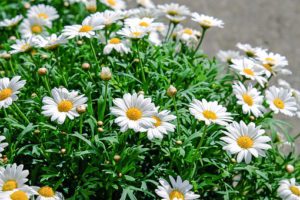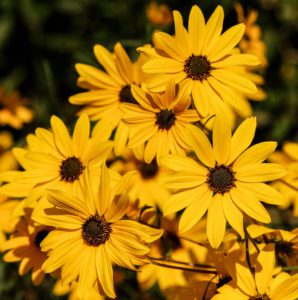How to Plant and Grow Daisy Flowers Outdoors

Brighten up your gardens and landscapes with daisy flowers, these garden beauties are native to North and Central Europe. There are many varieties of daisies that belong to the Asteraceae family, in fact, this number is said to be as high as 23,000 individual species. Daisies are large flowers with star-shaped heads, it’s believed that daisies were first cultivated as far back as 2,200 BC.
Some variety of daisies is considered to be annuals in colder regions while in warmer climates they are viewed as perennials. It’s said that “daisies are used in herbal medicine and can be eaten in salads” daisies can also be found growing in the wild and attracts pollinators such as bees. Install daisies in your garden and landscape and take advantage of these garden beauties that have so many benefits.
The planting location
The area that is chosen to install your daisy flowering plant should get at least 6-8 hours of sunlight.
The soil type
A well-drained soil that is rich in organics is ideal for your daisies to grow their best. If sowing from seeds install at a depth of 1/8 inches and space seeds 8-12 inches apart.
Daisy water requirements
The soil of daisies should be kept moist especially when growing from seeds in climates that are hot and dry.
Daisy fertilizer requirements
During the spring and summer months which is the growing season fertilizer your daisies with an all-purpose fertilizer. A quick-release or liquid feed fertilizer such as 15-5-15 is ideal. Apply fertilizer once a month during the growing season. Before applying fertilizers read and follow the manufacturer’s directions.
Garden pests of daisies
Be on the lookout for these garden pests and treat them when spotted.

- Slugs
- Earwigs
- Aphids
- Deers
- Rabbits
- Nematodes
- Whiteflies
- Spider Mites
Slugs
Slugs cause damage by eating daisies which can leave these garden plants looking sickly. The use of snail baits or handpicking slugs and throwing them into a bucket of soapy water will bring control.
Earwigs
Although these garden insects help to eliminate insect pests that will destroy your plant they too cause damage by eating parts of plants leaves along with leaving behind their excrement which is black. To control earwigs the use of diatomaceous earth will offer help. Diatomaceous is only effective once the ground is dry, placing a ring of diatomaceous around your plants will give results.
Aphids
Aphids are pear-shaped and can either be black, red, yellow, green, or brown. Aphids are among the sucking insect group and will cause flowers to drop. These garden insect pests also produce a sticky substance known as honeydew. This honeydew is their excrement that causes sooty mold to form. Applying soapy water or insecticidal soap will bring aphid infestation under control.
Whiteflies
Whiteflies are tiny white insects that dose damage as spider mites and aphids. They are easy to notice, gently shake the leaves and if the infestation is whiteflies they will quickly dislodge from your daisies but will quickly reattach to the plant just as fast. Neem oil or insecticidal soap has proven to be effective.
Spider Mites
Spider mites are very tiny insects that are hard to detect, signs that your plant has spider mites may include webbing on the plant, your daisy may also take on a dusty appearance. A sure test to know if the culprits are spider mites is to hold a white sheet of paper under the stem and leaves, gently sake the plant if spider mites are present you will see tiny specks moving around on that white sheet of paper. You may also feel them crawling on your hands, the use of insecticidal soap or horticultural will bring them under control.
Deers
Deers are beautiful animals that move about so gracefully but they can become a nuisance to home gardens. If deers are seeking to make a meal out of your daisies then consider installing plants such as foxgloves, peonies, lavenders, salvias, sage, daffodils, etc… will keep deers at bay.
Rabbits
Rabbits are cute and cuddly but apart from that they can cause real issues when it comes to daisies, rabbits will seek out these flowering plants as food. Installing a tall fence around your plants, the use of rabbit-repellent sprays will keep rabbits away.
Nematodes
Nematodes are microscopic warm like organisms that inhabit the soil, signs of the presence of nematodes include wilting of the foliage in hot weather even though daises are being irrigated. The foliage will also turn yellow, this is the only visible sign above the ground.
Further investigate by uprooting your daisy, if the culprit is nematodes you will discover galls or a growth growing on the plant’s roots. Unfortunately, there is no cure except to remove and properly dispose of daises. To control or prevent nematodes a procedure known as solarization will help greatly before planting seedlings or sowing seeds.
Daisy garden plant disease
Treat these diseases immediately when spotted
- Verticillium wilt and Stem rot
- Botrytis Blight
- Leaf Spot
- Powdery Mildew
Verticillium wilt and Stem rot
These diseases are encouraged by nematodes, fungi, and bacteria that are active in the soil, if your daisies show symptoms of this disease then it’s best to uproot and properly dispose of plants. Avoid replanting in the same location, with verticillium signs including yellow of the leaves along with wilting. Plants that are infected with verticillium may not recover.
Botrytis Blight
Symptoms of botrytis blight include stems and leave turning brown along with buds that are affected. This disease is spread by splashing water. A moldy substance may appear on plant parts also lesions that are brown and moist may appear. Hot weather will increase this issue, the use of a fungicide that contains chlorothalonil will bring control. The removal of infected plant parts will offer help also.
Leaf Spot
The symptoms of leaf spots include the appearance of spots that turns from yellow, brown, and then black, killing the leaf. Water splashing from diseased plants onto healthy plants encourages this disease. the use of a fungicide that contains chlorothalonil will bring control. The removal of infected plant parts will offer help also.
Powdery Mildew
Powdery mildew is a white powder-like substance that appears on the leaves of garden plants, this disease is caused by poor air circulation and weather that are very humid. To bring this disease under control make sure that garden plants have the right spacing for proper airflow, the use of a fungicide that is labeled for this disease will bring under control.
Some ideas where to install your daisy flowering plants
1. Install daisies in your garden plant beds.
2. Install them as border plants.
3. Plant daisies alongside your garden path walkway.
4. Install alongside your fence area.
5. Place an arrangement of daisies alongside your wall.
6. Place daisies in containers and place the containers on either side of your main door entrance.
7. Place containers with daisies on your patio.
8. Plant daisies around the trunk of trees provided they are getting sufficient sunlight.
Container grown daisies
Install your daisies in a container that is large enough to accommodate them, the container should have drain holes for water drainage to avoid root rot and organic-rich well-drained soil or a good garden loamy soil is ideal, these soil types will hold the right amount of water but will allow excess water to drain through.
If sowing from seeds install at a depth of 1/8 inches and space seeds 8-12 inches apart. The soil should be somewhat moist and not waterlogged. The container should be placed in an area that gets full sunlight. Fertilize and treat for disease and garden insect pests as discussed above.
Deadheading daisies
Deadheading your daisies will take them through a rejuvenation process that will keep them growing and blooming their best. When the time comes to deadhead daisies you will notice flowers that are faded, wilted, and turning brown, even if seed heads have formed they can be removed back to the first set of leaves. If there are no more flower buds and the leaves are not that healthy-looking remove the entire stem back to the foliage at the base of the plant.
The final word
Growing and caring for daisies is that simple, fill your summer and spring gardens with these beauties you will be so happy that you did as daises go to work for you sprucing up your gardens and landscapes with their amazing colors bringing that wow. Go ahead and join the many homeowners who are taking advantage of these plants.
About the author
Norman loves being in the garden, both at home and for his job....
he is 'Natures Little helper' being outdoors, growing his vegetables and flowers from an early age.
Now having spent over 22 years in the profession he want to give some of his knowledge to others...
his vast array of hints and tips you will find scattered over this site will help you no end growing plants in your garden.
